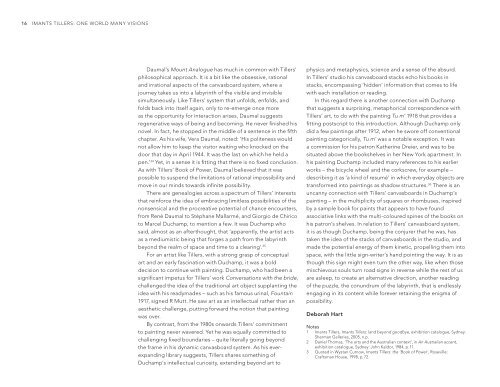introduction: a work in progress - National Gallery of Australia
introduction: a work in progress - National Gallery of Australia
introduction: a work in progress - National Gallery of Australia
Create successful ePaper yourself
Turn your PDF publications into a flip-book with our unique Google optimized e-Paper software.
16 IMANTS TILLERS: ONE WORLD MANY VISIONS<br />
Daumal’s Mount Analogue has much <strong>in</strong> common with Tillers’<br />
philosophical approach. It is a bit like the obsessive, rational<br />
and irrational aspects <strong>of</strong> the canvasboard system, where a<br />
journey takes us <strong>in</strong>to a labyr<strong>in</strong>th <strong>of</strong> the visible and <strong>in</strong>visible<br />
simultaneously. Like Tillers’ system that unfolds, enfolds, and<br />
folds back <strong>in</strong>to itself aga<strong>in</strong>, only to re-emerge once more<br />
as the opportunity for <strong>in</strong>teraction arises, Daumal suggests<br />
regenerative ways <strong>of</strong> be<strong>in</strong>g and becom<strong>in</strong>g. He never f<strong>in</strong>ished his<br />
novel. In fact, he stopped <strong>in</strong> the middle <strong>of</strong> a sentence <strong>in</strong> the fifth<br />
chapter. As his wife, Vera Daumal, noted: ‘His politeness would<br />
not allow him to keep the visitor wait<strong>in</strong>g who knocked on the<br />
door that day <strong>in</strong> April 1944. It was the last on which he held a<br />
pen.’ 34 Yet, <strong>in</strong> a sense it is fitt<strong>in</strong>g that there is no fixed conclusion.<br />
As with Tillers’ Book <strong>of</strong> Power, Daumal believed that it was<br />
possible to suspend the limitations <strong>of</strong> rational impossibility and<br />
move <strong>in</strong> our m<strong>in</strong>ds towards <strong>in</strong>f<strong>in</strong>ite possibility.<br />
There are genealogies across a spectrum <strong>of</strong> Tillers’ <strong>in</strong>terests<br />
that re<strong>in</strong>force the idea <strong>of</strong> embrac<strong>in</strong>g limitless possibilities <strong>of</strong> the<br />
nonsensical and the procreative potential <strong>of</strong> chance encounters,<br />
from René Daumal to Stéphane Mallarmé, and Giorgio de Chirico<br />
to Marcel Duchamp, to mention a few. It was Duchamp who<br />
said, almost as an afterthought, that ‘apparently, the artist acts<br />
as a mediumistic be<strong>in</strong>g that forges a path from the labyr<strong>in</strong>th<br />
beyond the realm <strong>of</strong> space and time to a clear<strong>in</strong>g’. 35<br />
For an artist like Tillers, with a strong grasp <strong>of</strong> conceptual<br />
art and an early fasc<strong>in</strong>ation with Duchamp, it was a bold<br />
decision to cont<strong>in</strong>ue with pa<strong>in</strong>t<strong>in</strong>g. Duchamp, who had been a<br />
significant impetus for Tillers’ <strong>work</strong> Conversations with the bride,<br />
challenged the idea <strong>of</strong> the traditional art object supplant<strong>in</strong>g the<br />
idea with his readymades – such as his famous ur<strong>in</strong>al, Founta<strong>in</strong><br />
1917, signed R Mutt. He saw art as an <strong>in</strong>tellectual rather than an<br />
aesthetic challenge, putt<strong>in</strong>g forward the notion that pa<strong>in</strong>t<strong>in</strong>g<br />
was over.<br />
By contrast, from the 1980s onwards Tillers’ commitment<br />
to pa<strong>in</strong>t<strong>in</strong>g never wavered. Yet he was equally committed to<br />
challeng<strong>in</strong>g fixed boundaries – quite literally go<strong>in</strong>g beyond<br />
the frame <strong>in</strong> his dynamic canvasboard system. As his everexpand<strong>in</strong>g<br />
library suggests, Tillers shares someth<strong>in</strong>g <strong>of</strong><br />
Duchamp’s <strong>in</strong>tellectual curiosity, extend<strong>in</strong>g beyond art to<br />
physics and metaphysics, science and a sense <strong>of</strong> the absurd.<br />
In Tillers’ studio his canvasboard stacks echo his books <strong>in</strong><br />
stacks, encompass<strong>in</strong>g ‘hidden’ <strong>in</strong>formation that comes to life<br />
with each <strong>in</strong>stallation or read<strong>in</strong>g.<br />
In this regard there is another connection with Duchamp<br />
that suggests a surpris<strong>in</strong>g, metaphorical correspondence with<br />
Tillers’ art, to do with the pa<strong>in</strong>t<strong>in</strong>g Tu m’ 1918 that provides a<br />
fitt<strong>in</strong>g postscript to this <strong><strong>in</strong>troduction</strong>. Although Duchamp only<br />
did a few pa<strong>in</strong>t<strong>in</strong>gs after 1912, when he swore <strong>of</strong>f conventional<br />
pa<strong>in</strong>t<strong>in</strong>g categorically, Tu m’ was a notable exception. It was<br />
a commission for his patron Kather<strong>in</strong>e Dreier, and was to be<br />
situated above the bookshelves <strong>in</strong> her New York apartment. In<br />
his pa<strong>in</strong>t<strong>in</strong>g Duchamp <strong>in</strong>cluded many references to his earlier<br />
<strong>work</strong>s – the bicycle wheel and the corkscrew, for example –<br />
describ<strong>in</strong>g it as ‘a k<strong>in</strong>d <strong>of</strong> resumé’ <strong>in</strong> which everyday objects are<br />
transformed <strong>in</strong>to pa<strong>in</strong>t<strong>in</strong>gs as shadow structures. 36 There is an<br />
uncanny connection with Tillers’ canvasboards <strong>in</strong> Duchamp’s<br />
pa<strong>in</strong>t<strong>in</strong>g – <strong>in</strong> the multiplicity <strong>of</strong> squares or rhombuses, <strong>in</strong>spired<br />
by a sample book for pa<strong>in</strong>ts that appears to have found<br />
associative l<strong>in</strong>ks with the multi-coloured sp<strong>in</strong>es <strong>of</strong> the books on<br />
his patron’s shelves. In relation to Tillers’ canvasboard system,<br />
it is as though Duchamp, be<strong>in</strong>g the conjurer that he was, has<br />
taken the idea <strong>of</strong> the stacks <strong>of</strong> canvasboards <strong>in</strong> the studio, and<br />
made the potential energy <strong>of</strong> them k<strong>in</strong>etic, propell<strong>in</strong>g them <strong>in</strong>to<br />
space, with the little sign-writer’s hand po<strong>in</strong>t<strong>in</strong>g the way. It is as<br />
though this sign might even turn the other way, like when those<br />
mischievous souls turn road signs <strong>in</strong> reverse while the rest <strong>of</strong> us<br />
are asleep, to create an alternative direction, another read<strong>in</strong>g<br />
<strong>of</strong> the puzzle, the conundrum <strong>of</strong> the labyr<strong>in</strong>th, that is endlessly<br />
engag<strong>in</strong>g <strong>in</strong> its content while forever reta<strong>in</strong><strong>in</strong>g the enigma <strong>of</strong><br />
possibility.<br />
Deborah Hart<br />
Notes<br />
1 Imants Tillers, Imants Tillers: land beyond goodbye, exhibition catalogue, Sydney:<br />
Sherman Galleries, 2005, n.p.<br />
2 Daniel Thomas, ‘The arts and the <strong>Australia</strong>n context’, <strong>in</strong> An <strong>Australia</strong>n accent,<br />
exhibition catalogue, Sydney: John Kaldor, 1984, p. 11.<br />
3 Quoted <strong>in</strong> Wystan Curnow, Imants Tillers: the ‘Book <strong>of</strong> Power’, Roseville:<br />
Craftsman House, 1998, p. 72.

















